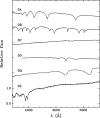The spectral evolution of white dwarfs: where do we stand?
- PMID: 38681903
- PMCID: PMC11052726
- DOI: 10.1007/s10509-024-04307-5
The spectral evolution of white dwarfs: where do we stand?
Abstract
White dwarfs are the dense, burnt-out remnants of the vast majority of stars, condemned to cool over billions of years as they steadily radiate away their residual thermal energy. To first order, their atmosphere is expected to be made purely of hydrogen due to the efficient gravitational settling of heavier elements. However, observations reveal a much more complex situation, as the surface of a white dwarf (1) can be dominated by helium rather than hydrogen, (2) can be polluted by trace chemical species, and (3) can undergo significant composition changes with time. This indicates that various mechanisms of element transport effectively compete against gravitational settling in the stellar envelope. This phenomenon is known as the spectral evolution of white dwarfs and has important implications for Galactic, stellar, and planetary astrophysics. This invited review provides a comprehensive picture of our current understanding of white dwarf spectral evolution. We first describe the latest observational constraints on the variations in atmospheric composition along the cooling sequence, covering both the dominant and trace constituents. We then summarise the predictions of state-of-the-art models of element transport in white dwarfs and assess their ability to explain the observed spectral evolution. Finally, we highlight remaining open questions and suggest avenues for future work.
Keywords: Atmospheric composition (2120); Stellar evolution (1599); White dwarf stars (1799).
© The Author(s) 2024.
Conflict of interest statement
Competing interestsThe authors declare no competing interests.
Figures













Similar articles
-
A rotating white dwarf shows different compositions on its opposite faces.Nature. 2023 Aug;620(7972):61-66. doi: 10.1038/s41586-023-06171-9. Epub 2023 Jul 19. Nature. 2023. PMID: 37468630
-
White dwarf stars with carbon atmospheres.Nature. 2007 Nov 22;450(7169):522-4. doi: 10.1038/nature06318. Nature. 2007. PMID: 18033290
-
Buoyant crystals halt the cooling of white dwarf stars.Nature. 2024 Mar;627(8003):286-288. doi: 10.1038/s41586-024-07102-y. Epub 2024 Mar 6. Nature. 2024. PMID: 38448597
-
M stars as targets for terrestrial exoplanet searches and biosignature detection.Astrobiology. 2007 Feb;7(1):85-166. doi: 10.1089/ast.2006.0125. Astrobiology. 2007. PMID: 17407405 Review.
-
The Evolution of Compact Binary Star Systems.Living Rev Relativ. 2006;9(1):6. doi: 10.12942/lrr-2006-6. Epub 2006 Dec 19. Living Rev Relativ. 2006. PMID: 28163653 Free PMC article. Review.
References
-
- Alcock C., Illarionov A. The surface chemistry of stars - part two - fractionated accretion of interstellar matter. Astrophys. J. 1980;235:541. doi: 10.1086/157657. - DOI
-
- Althaus L.G., Benvenuto O.G. Evolution of DA white dwarfs in the context of a new theory of convection. Mon. Not. R. Astron. Soc. 1998;296(1):206–216. doi: 10.1046/j.1365-8711.1998.01332.x. - DOI
-
- Althaus L.G., Córsico A.H. The double-layered chemical structure in DB white dwarfs. Astron. Astrophys. 2004;417:1115–1123. doi: 10.1051/0004-6361:20040021. - DOI
-
- Althaus L.G., Miller Bertolami M.M., Córsico A.H., et al. The formation of DA white dwarfs with thin hydrogen envelopes. Astron. Astrophys. 2005;440(1):L1–L4. doi: 10.1051/0004-6361:200500159. - DOI
-
- Althaus L.G., Serenelli A.M., Panei J.A., et al. The formation and evolution of hydrogen-deficient post-AGB white dwarfs: the emerging chemical profile and the expectations for the PG 1159-DB-DQ evolutionary connection. Astron. Astrophys. 2005;435(2):631–648. doi: 10.1051/0004-6361:20041965. - DOI
Publication types
LinkOut - more resources
Full Text Sources
